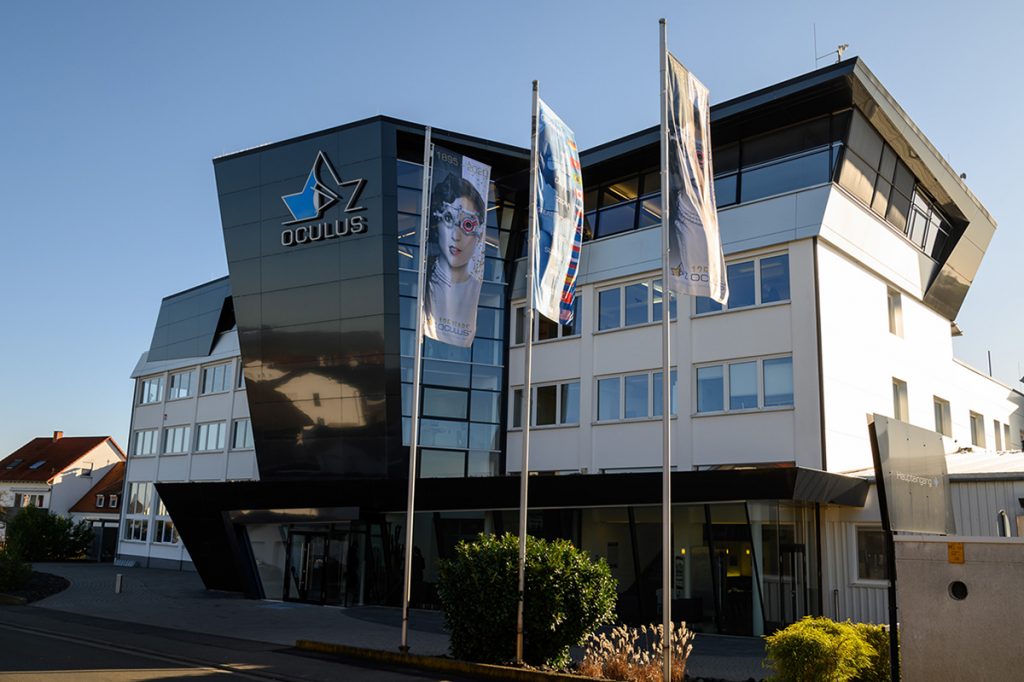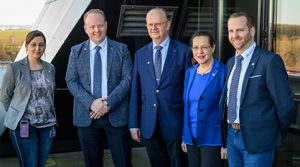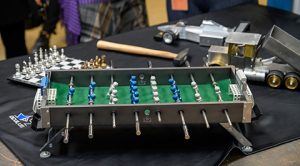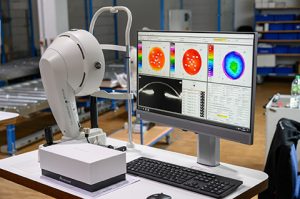All in the family
German company celebrates 125 years of innovation

Aidan Hanratty
Published: Friday, May 1, 2020
[caption id="attachment_19641" align="alignleft" width="1024"] Oculus headquarters in Wetzlar[/caption]
Oculus has always been a family business. Originally established in 1895 by Alois Mager, it was originally called the A. Mager Specialist Factory for Ophthalmological Instruments [A. Mager Spezialfabrik Ophthalmologischer Instrumente]. Early products included a universal trial frame, an ophthalmoscope, a Javal ophthalmometer and a Förster arc perimeter.
Mager’s son Wilhelm joined the company in 1922, and acted as managing director from 1924 until 1956. In that time the company name changed to Oculus (1932) and the firm moved from Berlin to the “optic town” of Wetzlar (1947). It was at this time that graduate engineer Kurt Kirchhübel joined the company as additional managing director, a role he held until 1986.
Oculus headquarters in Wetzlar[/caption]
Oculus has always been a family business. Originally established in 1895 by Alois Mager, it was originally called the A. Mager Specialist Factory for Ophthalmological Instruments [A. Mager Spezialfabrik Ophthalmologischer Instrumente]. Early products included a universal trial frame, an ophthalmoscope, a Javal ophthalmometer and a Förster arc perimeter.
Mager’s son Wilhelm joined the company in 1922, and acted as managing director from 1924 until 1956. In that time the company name changed to Oculus (1932) and the firm moved from Berlin to the “optic town” of Wetzlar (1947). It was at this time that graduate engineer Kurt Kirchhübel joined the company as additional managing director, a role he held until 1986.
 Kerstin Kirchhübel, Christian Kirchhübel,
Rainer Kirchhübel, Rita Kirchhübel
and Matthias Kirchhübel
Kurt’s son Rainer joined the company in 1979 and became a member of the board two years later. Today he is co-director with his own son, Christian, while his wife Rita is Marketing Director.
Just as the key personnel can trace a long lineage, so do some of the key components of the business. Trial frames have been a key part of the company since the beginning. The current standard, the UB 6, is composed of 166 parts, all of which are crafted and assembled by hand on site in Wetzlar.
These frames “keep the company going”, according to Christian. Providing a high-quality product at a reasonable price point is a core competency for Oculus, especially when another one of those core aims is the durability of its machines. “What I want to put in the foreground is the sustainability of the devices,” said Rita.
“You will not find a used Pentacam on the entire market, it has been on the market since 2002. We have been serving our customers with software updates and extensions for decades.”
Similarly, the concept of static perimetry goes back to the company’s work with the University Eye Clinic in Tübingen in 1958, resulting in the creation of the “Tübinger Hand-Perimeter”.
“This static perimetry is the basic requirement that we have in all automatic perimeters today,” said Rainer. “Not only in our devices but all automatic perimeters that are offered in the world – they all work with static perimetry. The device here was a highly complex, scientific device – you almost had to be trained in Tübingen to operate it.”
On the company’s 100th anniversary in 1995 they launched the Twinfield device, offering static and kinetic perimetry as both manual and automatic options. They now offer four devices for visual field tests, for a range of markets.
That’s not to say that everything is refined and updated. In 1985 the company developed the SDI/BIOM (stereoscopic diagonal inverter and binocular indirect ophthalmomicroscope) for wide-angle vitreoretinal surgery. The BIOM is now on its fifth generation, with automatic and manual inversion as well as accompanying customisable sterilisation packs.
In 2019 it introduced the Myopia Master, an all-in-one device for performing refraction, axial length measurement and keratometry. The device creates reports for each patient, as well as taking into account risk factors such as family history and lifestyle.
Oculus has also collaborated with the Brien Holden Vision Institute in Australia (BHVI), incorporating its algorithms for tracking and estimating refractive error into the device. Available to opticians, optometrists and ophthalmologists, this device may prove key in the management of myopia in the face of a global epidemic.
Kerstin Kirchhübel, Christian Kirchhübel,
Rainer Kirchhübel, Rita Kirchhübel
and Matthias Kirchhübel
Kurt’s son Rainer joined the company in 1979 and became a member of the board two years later. Today he is co-director with his own son, Christian, while his wife Rita is Marketing Director.
Just as the key personnel can trace a long lineage, so do some of the key components of the business. Trial frames have been a key part of the company since the beginning. The current standard, the UB 6, is composed of 166 parts, all of which are crafted and assembled by hand on site in Wetzlar.
These frames “keep the company going”, according to Christian. Providing a high-quality product at a reasonable price point is a core competency for Oculus, especially when another one of those core aims is the durability of its machines. “What I want to put in the foreground is the sustainability of the devices,” said Rita.
“You will not find a used Pentacam on the entire market, it has been on the market since 2002. We have been serving our customers with software updates and extensions for decades.”
Similarly, the concept of static perimetry goes back to the company’s work with the University Eye Clinic in Tübingen in 1958, resulting in the creation of the “Tübinger Hand-Perimeter”.
“This static perimetry is the basic requirement that we have in all automatic perimeters today,” said Rainer. “Not only in our devices but all automatic perimeters that are offered in the world – they all work with static perimetry. The device here was a highly complex, scientific device – you almost had to be trained in Tübingen to operate it.”
On the company’s 100th anniversary in 1995 they launched the Twinfield device, offering static and kinetic perimetry as both manual and automatic options. They now offer four devices for visual field tests, for a range of markets.
That’s not to say that everything is refined and updated. In 1985 the company developed the SDI/BIOM (stereoscopic diagonal inverter and binocular indirect ophthalmomicroscope) for wide-angle vitreoretinal surgery. The BIOM is now on its fifth generation, with automatic and manual inversion as well as accompanying customisable sterilisation packs.
In 2019 it introduced the Myopia Master, an all-in-one device for performing refraction, axial length measurement and keratometry. The device creates reports for each patient, as well as taking into account risk factors such as family history and lifestyle.
Oculus has also collaborated with the Brien Holden Vision Institute in Australia (BHVI), incorporating its algorithms for tracking and estimating refractive error into the device. Available to opticians, optometrists and ophthalmologists, this device may prove key in the management of myopia in the face of a global epidemic.
 Examples of designs produced by apprentice engineers
Sustainability is a key factor for Oculus, and that’s evident on all levels of operations in their factory in Wetzlar, where EuroTimes attended a press day to mark the company’s 125th anniversary. The company runs an apprenticeship programme, taking teenagers into their workshops and training them in all aspects of engineering. They learn to make and build things, operate machinery and so on. A small display showed items made by apprentices, including race cars, a foosball table, a chess set and a hammer. As Christian says, if apprentices don’t understand the most basic principles of how things are made, they won’t understand the bigger picture.
The company has trained 74 industrial mechanics in the past 20 years. These are now working across the board in preparation, assembly and service, as industrial mechanics and electronic technicians.
“We have a total of 400 employees here today, that’s a quarter of the employees who are trained here,” says Rainer. “If you then look at the fact that another 100 of the 400 have been in the house for more than 25 years – that’s a long bond. We have a relatively low turnover, we are actually very proud that once someone has decided to work here, they will stay here.”
Examples of designs produced by apprentice engineers
Sustainability is a key factor for Oculus, and that’s evident on all levels of operations in their factory in Wetzlar, where EuroTimes attended a press day to mark the company’s 125th anniversary. The company runs an apprenticeship programme, taking teenagers into their workshops and training them in all aspects of engineering. They learn to make and build things, operate machinery and so on. A small display showed items made by apprentices, including race cars, a foosball table, a chess set and a hammer. As Christian says, if apprentices don’t understand the most basic principles of how things are made, they won’t understand the bigger picture.
The company has trained 74 industrial mechanics in the past 20 years. These are now working across the board in preparation, assembly and service, as industrial mechanics and electronic technicians.
“We have a total of 400 employees here today, that’s a quarter of the employees who are trained here,” says Rainer. “If you then look at the fact that another 100 of the 400 have been in the house for more than 25 years – that’s a long bond. We have a relatively low turnover, we are actually very proud that once someone has decided to work here, they will stay here.”
 The Pentacam AXL
The Pentacam, which was introduced to the market in 2002, is now the flagship device in the Oculus arsenal. A rotating Scheimpflug camera system for anterior segment analysis, it measures topography and elevation of the anterior and posterior corneal surface as well as corneal thickness. Further to the original device, there is also the Pentacam HR, offering high-resolution imaging, and the Pentacam AXL, with integrated axial length measurement for IOL calculations. Furthermore, in 2019 the company introduced the Pentcam AXL Wave, offering wavefront aberrometry along with Scheimpflug tomography, optical biometry, refraction and retroillumination.
As well as selling these devices, Oculus makes sure to inform its customers how to use them. The company runs an academy with domestic and international symposia on a regular basis. “This year we trained 1,636 opticians and ophthalmologists with the academy,” said Rainer. “And this is not just advertising for Oculus products, I think you take something away with you where you see a completely different area of application.”
“It is increasingly the case that the device itself has become so complex by now,” adds Christian.” “Many people buy a device and find that they only use it so much and could actually do so much more.” The academy therefore shows the full scope of possibility with each device.
On a lighter note, the company is proud to have on its walls the largest eye test in the world. Along with the completion of the company’s new logistics centre in 2015, they placed on the outer walls a vision test that can be seen from a viewing platform 1.5km away.
“We had [former world number one table tennis player] Timo Boll here with us as a guest of honour; he tried the test first – he passed the test quite well. We then tested internally with him here too, I think he managed a visual acuity of 1.6 or 2.0, which is why he can play table tennis quite well,” said Rainer.
From small beginnings to world records, it’s clear this family business is in good shape for looking to its next milestone.
The Pentacam AXL
The Pentacam, which was introduced to the market in 2002, is now the flagship device in the Oculus arsenal. A rotating Scheimpflug camera system for anterior segment analysis, it measures topography and elevation of the anterior and posterior corneal surface as well as corneal thickness. Further to the original device, there is also the Pentacam HR, offering high-resolution imaging, and the Pentacam AXL, with integrated axial length measurement for IOL calculations. Furthermore, in 2019 the company introduced the Pentcam AXL Wave, offering wavefront aberrometry along with Scheimpflug tomography, optical biometry, refraction and retroillumination.
As well as selling these devices, Oculus makes sure to inform its customers how to use them. The company runs an academy with domestic and international symposia on a regular basis. “This year we trained 1,636 opticians and ophthalmologists with the academy,” said Rainer. “And this is not just advertising for Oculus products, I think you take something away with you where you see a completely different area of application.”
“It is increasingly the case that the device itself has become so complex by now,” adds Christian.” “Many people buy a device and find that they only use it so much and could actually do so much more.” The academy therefore shows the full scope of possibility with each device.
On a lighter note, the company is proud to have on its walls the largest eye test in the world. Along with the completion of the company’s new logistics centre in 2015, they placed on the outer walls a vision test that can be seen from a viewing platform 1.5km away.
“We had [former world number one table tennis player] Timo Boll here with us as a guest of honour; he tried the test first – he passed the test quite well. We then tested internally with him here too, I think he managed a visual acuity of 1.6 or 2.0, which is why he can play table tennis quite well,” said Rainer.
From small beginnings to world records, it’s clear this family business is in good shape for looking to its next milestone.
 Oculus headquarters in Wetzlar[/caption]
Oculus has always been a family business. Originally established in 1895 by Alois Mager, it was originally called the A. Mager Specialist Factory for Ophthalmological Instruments [A. Mager Spezialfabrik Ophthalmologischer Instrumente]. Early products included a universal trial frame, an ophthalmoscope, a Javal ophthalmometer and a Förster arc perimeter.
Mager’s son Wilhelm joined the company in 1922, and acted as managing director from 1924 until 1956. In that time the company name changed to Oculus (1932) and the firm moved from Berlin to the “optic town” of Wetzlar (1947). It was at this time that graduate engineer Kurt Kirchhübel joined the company as additional managing director, a role he held until 1986.
Oculus headquarters in Wetzlar[/caption]
Oculus has always been a family business. Originally established in 1895 by Alois Mager, it was originally called the A. Mager Specialist Factory for Ophthalmological Instruments [A. Mager Spezialfabrik Ophthalmologischer Instrumente]. Early products included a universal trial frame, an ophthalmoscope, a Javal ophthalmometer and a Förster arc perimeter.
Mager’s son Wilhelm joined the company in 1922, and acted as managing director from 1924 until 1956. In that time the company name changed to Oculus (1932) and the firm moved from Berlin to the “optic town” of Wetzlar (1947). It was at this time that graduate engineer Kurt Kirchhübel joined the company as additional managing director, a role he held until 1986.
 Kerstin Kirchhübel, Christian Kirchhübel,
Rainer Kirchhübel, Rita Kirchhübel
and Matthias Kirchhübel
Kerstin Kirchhübel, Christian Kirchhübel,
Rainer Kirchhübel, Rita Kirchhübel
and Matthias Kirchhübel Examples of designs produced by apprentice engineers
Examples of designs produced by apprentice engineers The Pentacam AXL
The Pentacam AXLLatest Articles
Organising for Success
Professional and personal goals drive practice ownership and operational choices.
Update on Astigmatism Analysis
Is Frugal Innovation Possible in Ophthalmology?
Improving access through financially and environmentally sustainable innovation.
iNovation Innovators Den Boosts Eye Care Pioneers
New ideas and industry, colleague, and funding contacts among the benefits.
Making IOLs a More Personal Choice
Surgeons may prefer some IOLs for their patients, but what about for themselves?
Need to Know: Higher-Order Aberrations and Polynomials
This first instalment in a tutorial series will discuss more on the measurement and clinical implications of HOAs.
Never Go In Blind
Novel ophthalmic block simulator promises higher rates of confidence and competence in trainees.
Simulators Benefit Surgeons and Patients
Helping young surgeons build confidence and expertise.
How Many Surgeries Equal Surgical Proficiency?
Internet, labs, simulators, and assisting surgery all contribute.